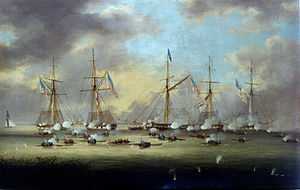USS Alligator (1813)
| Career (United States) | |
|---|---|
| Name: | USS Alligator |
| Acquired: | Purchased, 1813 |
| Fate: | Captured, 14 December 1814 |
| General characteristics | |
| Type: | Sloop |
| Propulsion: | Sail |
| Complement: | 8 |
| Armament: | 1 × 4-pounder gun |
USS Alligator was a sloop in the United States Navy during the War of 1812. The U.S. Navy purchased Alligator in 1813 at New Orleans, Louisiana. Commissioned as a tender at New Orleans, she served on that station under the command of Sailing Master Richard S. Sheppard until late in 1814 when the British captured her at the Battle of Lake Borgne.[1][2]
Service
After the capture of Pensacola on 7 November 1814 Major General Andrew Jackson arrived at New Orleans on 1 December to make preparations for the defense of that city. He organized with Master Commandant Daniel Patterson of the U.S. Navy to send a flotilla to Lake Borgne to guard and defend against the approach of Vice Admiral Sir Alexander Cochrane and his fleet.[Note 1]
Lieutenant Thomas Jones commanded the American flotilla of five large gunboats, which had about 180 men for the crews. The gunboats were armed with 24 and 32-pounder long guns, 6 and 12-pounder carronades, and swivel guns. Among the flotilla was the sloop-rigged Alligator with a long 6-pounder and two 12-pounder carronades with its crew of 20 men.
On 13 December after most of the British fleet arrived east of New Orleans, Cochrane sent commander Nicholas Lockyer with a flotilla of about 45 open ship's boats and barges armed with carronades and upwards of 1,000 Royal Navy and Royal Marines to attack Jones' flotilla.[4][5] [Note 2] By mid-morning Jones had discovered the British approaching his flotilla. He quickly pulled up anchors and retreated westward with orders from Patterson to defend the passage into Lake Pontchartrain at all costs as this lake would give the British naval access to New Orleans situated on its southern shore. At the time the water level of the lake (Borgne) was lower than normal which forced Jones to lighten the load of his vessels, allowing him to elude the approaching British boats. Jones sent Seahorse to remove ordnance and other supplies from the shore batteries on the north shore but part of the flotilla was cut off. After a brief skirmish Jones' forces retreated that evening after blowing up Seahorse and destroying the shore encampment. Unable to withdraw any further Jonesanchored his flotilla some 15 miles from the entrance of the lake. Lockyer's force could not advance in striking range due to the low tide, opposing currents and adverse winds until the morning of 14 December, when conditions became more favorable.[6]
After a short rest Lockyer launched his assault, first attacking the Alligator which had fallen behind the rest of the American flotilla. Being lightly armed it fell in little time. The remainder of the British flotilla now formed a long line and slowly advanced on the American positions on the lake. Jones had anchored his boats end to end forming a line and a broadside to block the anticipated British advance. As the British vessels came within striking range the American flotilla together fired a destructive broadside which temporarily repelled the attack. At this point the tide and current had changed again, causing some of the American gunboats to break formation, one of them occupied by Jones where both he and Lockyer sustained serious wounds from the ensuing battle. As the battle continued the British managed to cut through the boarding nets and overtook the American gunboats, turning and using them against the American forces to secure their victory.
Alligator's participation in the Battle of Lake Borgne — an American defeat, but one that helped to buy precious time for General Andrew Jackson's successful defense of New Orleans — proved very brief. Her disposition by the British is unknown.[2][7][8]
See also
- List of sailing frigates of the United States Navy
- Glossary of nautical terms
- Naval tactics in the Age of Sail
Notes
- ↑ Patterson was a prisoner with Commodore William Bainbridge in Tripoli during the First Barbary War [3] Cochrane was a seasoned veteran of the Napoleonic Wars
- ↑ Roosevelt cites the number of Royal Navy personnel at 980,[5] Malcomson gives a rounded number of 1,000,[4] while Cooper acknowledges that computations of this number vary from 1,200 to as low as 400, however he also notes that the sizes and number of the barges present at the battle render the lower number improbable.[6]
References
- ↑ Roosevelt, 1883 p.344.
- ↑ 2.0 2.1 U.S.Navy, DANFS, Alligator prgh.1
- ↑ Cooper, 1856 p.344
- ↑ 4.0 4.1 Malcomson, 2006 p.48
- ↑ 5.0 5.1 Roosevelt, 1901 p.240
- ↑ 6.0 6.1 Cooper, 1856 p.342
- ↑ Malcomson, 2006 pp.47-48.
- ↑ Cooper, 1856, pp.341-343.
Bibliography
- Cooper, James Fenimore (1856). History of the Navy of the United States of America. New York: Stringer & Townsend. OCLC 197401914.
- Dept U.S.Navy. "Alligator". Dictionary of American Naval Fighting Ships. Department of the Navy -- Naval Historical Center. Retrieved 18 October 2011.
- Malcomson, Robert (2006). Historical Dictionary of the War of 1812. Lanham, MD: Scarecrow Press. ISBN 0-8108-5499-6.
- Roosevelt, Theodore (1883). The Naval War of 1812 (3rd ed.). New York: G. P. Putnam's Sons. OCLC 3746791.
- Roosevelt, Theodore (1901). The Naval Operations of the War Between Great Britain and the United States, 1812-1815. Boston: Little, Brown, and Company. OCLC 12334018.
